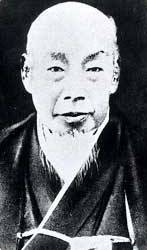Tanaka Hisashige
Tanaka Hisashige | |
|---|---|
 | |
| Born | September 18, 1799 |
| Died | November 7, 1881 (aged 82) Tokyo, Japan |
| Nationality | Japanese |
Template:Japanese name Tanaka Hisashige (田中 久重, September 18, 1799 – November 7, 1881) was a Japanese engineer and inventor during the late Edo and Meiji period Japan. He is one of the founders of what later became Toshiba Corporation. He has been called the "Thomas Edison of Japan" or Karakuri Giemon.[1]
Tanaka was born in Kurume, Chikugo province (present day Fukuoka prefecture) as the eldest son of a tortoise shell craftsman. A gifted artisan, in his youth he studied the design and construction of karakuri dolls, mechanical automatons capable of relatively complex movements, which were then much in demand by the aristocrats of Kyoto, daimyō in various feudal domains, and by the Shōgun’s court in Edo. At age 21, he was performing around the country at festivals with clockwork dolls he constructed himself.
In 1834, he relocated to Osaka, where he experimented in pneumatics, hydraulics and various forms of lighting based on rapeseed oil. However, he soon moved on to Kyoto, where he studied rangaku, or western learning, and astronomy. In 1851, he built a Myriad year clock which is now designated as an Important Cultural Property by the Japanese government. With the development of the Sonnō jōi movement, the atmosphere in Kyoto became increasingly dangerous towards foreign influences and technology, and Tanaka was invited by Sano Tsunetami to the Saga Domain in Kyūshū, where he was welcomed by Nabeshima Naomasa.
While in Saga, Tanaka designed and built Japan’s first domestically made steam locomotive and steam warship. Although he had no previous experience in the field, he had access to a Dutch reference book, and had watched the demonstration of a steam engine conducted by the Russian diplomat Yevfimy Putyatin during his visit to Nagasaki in 1853.
He was also involved in the construction of a reverberatory furnace in Saga for the production of Armstrong guns. In 1864, he returned to his native Kurume Domain, where he assisted in the development of modern weaponry.
Soon after the Meiji Restoration, in 1873 Tanaka moved to Tokyo, where he rented the second floor of a temple in what is now Roppongi as a workshop to produce telegraphs at the request of the new Meiji government. He relocated to the Ginza district in 1875.
After his death in 1882, his son founded Tanaka Engineering Works (田中製造所, Tanaka Seizōsho). The company changed its name after Tanaka’s death to Shibaura Engineering Works (芝浦製造所, Shibaura Seizōsho) in 1904, and after a merger in 1939 with Tokyo Denki became Tokyo Shibaura Denki, more commonly known today as Toshiba.
References
- Morris-Suzuki, Tessa. The Technological Transformation of Japan: From the Seventeenth to the Twenty-first Century Cambridge University Press, 1994. ISBN 0521424925
External links
-
Japan's first steam engine, manufactured in 1853 by Tanaka.


